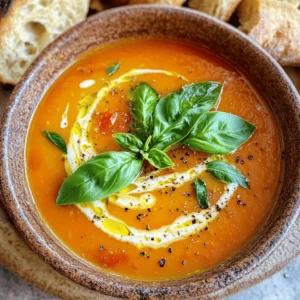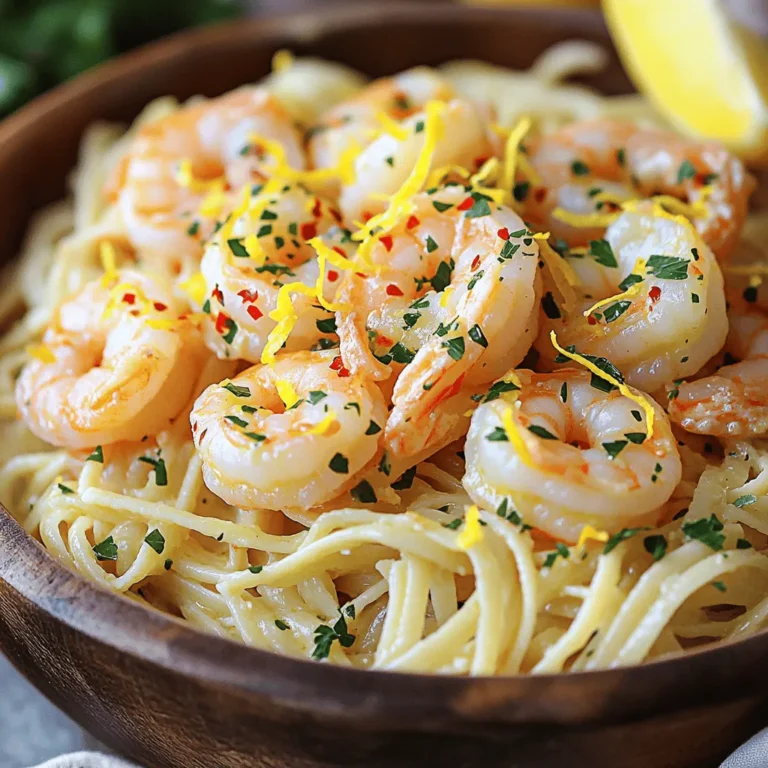Roasted Tomato Basil Soup Comforting and Flavorful Meal

If you love cozy meals, then you’ll adore my Roasted Tomato Basil Soup. This dish is rich, warm, and packed with flavor. It’s the perfect way to enjoy fresh tomatoes and aromatic herbs. In this blog post, I will guide you step by step, sharing my best tips for making it creamy and delicious. Let’s dive in and create a comforting bowl of soup together!
Ingredients
List of Essential Ingredients
To make a delicious roasted tomato basil soup, you need the following ingredients:
- 2 lbs ripe tomatoes, halved
- 1 large onion, roughly chopped
- 4 cloves garlic, peeled
- 2 tablespoons extra-virgin olive oil
- Salt and freshly ground black pepper, to taste
- 4 cups vegetable broth
- 1 cup fresh basil leaves, tightly packed
- ½ cup heavy cream or coconut cream
Optional Ingredients for Enhanced Flavor
You can add these optional ingredients to boost the flavor:
- 1 teaspoon sugar (to balance acidity)
- 1 tablespoon balsamic vinegar (for added depth)
Nutritional Information per Serving
This soup is packed with nutrients. Here’s the approximate nutritional info per serving (1 cup):
- Calories: 180
- Protein: 3g
- Carbohydrates: 10g
- Dietary Fiber: 2g
- Fat: 15g
Roasted tomato basil soup is not just tasty; it’s also good for you! The fresh tomatoes and basil provide vitamins and antioxidants. Enjoy this warm bowl of comfort, knowing you’re treating yourself well!
Step-by-Step Instructions
Preparation: Prepping Ingredients and Oven
First, gather all your ingredients. You need ripe tomatoes, onion, garlic, olive oil, salt, pepper, and basil. Don’t forget the vegetable broth and cream! Next, preheat your oven to 400°F (200°C). This heat will help caramelize the tomatoes and enhance their sweetness.
Roasting: Step-by-Step Roasting Instructions
On a large baking sheet, lay the halved tomatoes cut-side up. Scatter the chopped onion and garlic cloves around them. This way, all the flavors mix during roasting. Drizzle the olive oil over everything. Add salt, black pepper, and sugar if you want to balance the acidity. Place the baking sheet in your hot oven and roast for 30 to 35 minutes. The tomatoes will turn juicy, and the onions will become soft and sweet.
Simmering and Blending: Transforming Ingredients into Soup
After roasting, take the baking sheet out of the oven. Let the vegetables cool for a few minutes. Then, transfer them into a large pot with a spatula. Pour in the vegetable broth and heat it on medium. Bring the mix to a gentle simmer and cook for 10 minutes. This helps meld all the wonderful flavors. Stir in the fresh basil leaves and balsamic vinegar if you’re using it. Let it simmer for another 5 minutes. Finally, use an immersion blender to puree the soup until it’s smooth and creamy. You can also use a traditional blender in batches if you prefer. Stir in the heavy cream or coconut cream for added richness. Taste and adjust the seasoning with more salt and pepper if needed.
Tips & Tricks
Suggestions for Perfect Roasting
To get the best flavor from your tomatoes, choose ripe ones. Look for tomatoes that feel heavy and smell sweet. Cut them in half and place them cut-side up. This helps the juices stay in. Use a high heat of 400°F for roasting. This makes the tomatoes caramelized and sweet. Don’t forget the onions and garlic! They add rich flavors. Roast them together for about 30 to 35 minutes. Keep an eye on them. They should look soft and slightly charred.
Blending Tips for Creamy Texture
For a smooth soup, use an immersion blender. This tool is easy and quick. If you don’t have one, a regular blender works too. Just be careful; blend in small batches. This prevents spills. Blend until the soup is silky. Add the cream after blending. Heavy cream gives a rich taste, but coconut cream works for a dairy-free option. Stir well to mix everything.
Seasoning Tips for Best Flavor
Start with salt and black pepper. They bring out the natural taste of the tomatoes. If your soup is too acidic, add a teaspoon of sugar. This balances the flavors. For extra depth, try balsamic vinegar. It adds a nice tang. Taste your soup before serving. Adjust the salt and pepper based on your preference. Don’t skip the fresh basil! It adds a great aroma and taste.

Variations
Dairy-Free Adjustments
To make this soup dairy-free, simply swap heavy cream for coconut cream. Coconut cream gives a rich taste without dairy. It also adds a hint of sweetness, which blends well with the roasted tomatoes. If you’re looking for a lighter option, you can use almond milk or cashew cream. These options will still keep your soup creamy and enjoyable.
Alternative Herb and Spice Options
While basil is the star, you can also try other herbs. Oregano or thyme can add a lovely twist. For a spicy kick, consider adding a pinch of red pepper flakes. If you want a more aromatic flavor, try adding a bay leaf while simmering. Just remember to remove it before blending. These herbs and spices can enhance the overall taste and give your soup a new life.
Different Tomato Varieties for Unique Flavor
The type of tomatoes you choose can change the flavor of your soup. Ripe Roma tomatoes are great for their sweetness and low water content. Heirloom tomatoes offer a robust taste and unique colors. Cherry tomatoes can bring a burst of sweetness. Each variety gives the soup a different character. Experiment with what you have or what you love to find your favorite mix.
Storage Info
How to Store Leftovers Properly
After you enjoy your roasted tomato basil soup, let it cool down. Then, pour the soup into airtight containers. Make sure to leave some space at the top of the container. This allows the soup to expand if it freezes. Label the containers with the date. Store in the fridge if you plan to eat it within a few days. If not, freezing is a great option.
Reheating Instructions
When you are ready to eat your soup again, you can reheat it easily. Pour your soup into a pot over medium heat. Stir it often to keep it smooth. Heat until it is hot, but do not let it boil. If the soup is too thick, you can add a splash of vegetable broth or water to thin it out. You can also use the microwave. Just heat in short bursts, stirring in between.
Freezing for Future Enjoyment
To freeze your soup, use the same airtight containers. It’s best to freeze it in smaller portions. This way, you can enjoy just what you need. The soup can last up to three months in the freezer. When you’re ready to eat it, let it thaw overnight in the fridge. Reheat it as mentioned above. Enjoy your comforting soup any time!
FAQs
What type of tomatoes are best for this soup?
I love using ripe, juicy tomatoes for this soup. Varieties like Roma or vine-ripened tomatoes work best. They have a rich flavor and fewer seeds. Choose tomatoes that feel heavy for their size. Avoid ones with blemishes or soft spots. Fresh tomatoes bring a sweet taste and vibrant color to your dish.
Can I use canned tomatoes instead of fresh?
Yes, you can use canned tomatoes! Look for whole or crushed tomatoes in good quality cans. Choose those packed in juice, not sauce. Canned tomatoes save time and still taste great. They can help you make soup even when fresh tomatoes are out of season. Just remember to adjust the seasoning since canned tomatoes can be saltier.
How do I make the soup vegan?
To make the soup vegan, skip the heavy cream or use coconut cream instead. This keeps it rich and creamy. Also, check your vegetable broth to ensure it is vegan-friendly. The rest of the recipe is already plant-based. You can still enjoy all the flavor without any animal products.
What can I serve with roasted tomato basil soup?
This soup pairs well with crusty bread or garlic toast. You can also serve it with a fresh salad for a full meal. Grilled cheese sandwiches are a classic choice too. They complement the soup’s warmth and flavor. For a fun twist, try adding a sprinkle of cheese or croutons on top of the soup.
This blog post provides all you need for making delicious roasted tomato basil soup. You learned about the key ingredients, cooking steps, and helpful tips for the best flavor. I also shared variations and storage tips to enjoy this soup later.
Roasting tomatoes enhances their taste, while blending gives it a creamy texture. With a few simple tweaks, you can make this dish suit your diet. Enjoy this warm, flavorful soup any time of the year. Happy cooking!


![To make crispy sweet and sour chicken, you need some key ingredients. Here’s what to gather: - 1 lb (450g) chicken breast, cut into bite-sized pieces - 1 cup cornstarch - 2 large eggs, beaten - Oil for frying - Salt and black pepper to taste These ingredients form the base of your dish. The chicken gives protein, while cornstarch creates that crispy texture. Eggs help the cornstarch stick to the chicken. Adding vibrant colors and fresh flavors is easy with the right vegetables and fruits. Here’s what you’ll need: - 1 cup bell peppers, chopped (mix of colors for visual appeal) - 1 cup pineapple chunks (fresh or canned) - 1 cup onion, chopped - 3 cloves garlic, minced The bell peppers and onions add crunch and sweetness. Pineapple brings a juicy burst of flavor. Garlic adds depth to the dish. The sweet and sour sauce makes this dish memorable. Gather these components: - 1/2 cup ketchup - 1/4 cup apple cider vinegar - 1/4 cup brown sugar - 2 tablespoons soy sauce - 1 tablespoon cornstarch mixed with 2 tablespoons water (for slurry) This sauce balances sweetness and tang. Ketchup gives a rich base, while apple cider vinegar adds a zesty kick. Brown sugar enhances the sweetness, and soy sauce adds umami. The cornstarch slurry thickens the sauce perfectly. For the full recipe, check out the complete list of steps to follow. Happy cooking! Start by seasoning the chicken pieces with salt and pepper. This simple step adds great flavor. Next, dredge each piece in cornstarch. Make sure to shake off any extra cornstarch. This helps create a nice, crispy crust. After that, dip the chicken pieces into the beaten eggs. This coating will help the cornstarch stick well. In a large skillet, heat oil over medium-high heat. You want the oil to shimmer before adding the chicken. Fry the chicken in batches. Avoid crowding the pan to keep the chicken crispy. Cook each piece for about 4-5 minutes per side. When golden brown, use a slotted spoon to remove the chicken. Place it on paper towels to drain any excess oil. Lower the heat to medium. In the same pan, add chopped onions and bell peppers. Sauté them for about 3-4 minutes or until soft. This brings out their sweetness. Then, add minced garlic and cook for another minute. The aroma will fill your kitchen and make your mouth water. In a bowl, whisk together the sauce ingredients: ketchup, apple cider vinegar, brown sugar, and soy sauce. Combine these until smooth. Pour this sweet and tangy sauce over the sautéed vegetables. Stir gently to mix everything together. The colors and smells will be inviting. Raise the heat slightly and bring the sauce to a gentle simmer. This helps blend the flavors. Once it simmers, add pineapple chunks for sweetness. Then, mix the cornstarch slurry and pour it in. Stir continuously until the sauce thickens, which takes about 2-3 minutes. You want it to coat the chicken well. Add the crispy chicken back into the pan. Carefully fold it into the thickening sauce. Toss everything gently to coat each piece of chicken. Once warmed through, the dish is ready to serve. For a great presentation, plate it over fluffy rice or steamed quinoa. You can also garnish it with sesame seeds and green onions for extra flair. To get that perfect crispy texture, start with your oil. Heat it well, around 350°F (175°C) is ideal. If the oil isn't hot enough, your chicken will soak up oil and get soggy. Fry the chicken in batches to avoid crowding. This keeps the oil temperature steady. Once fried, place the chicken on paper towels. This helps drain off any extra oil. For a twist on the classic sauce, try adding a splash of orange juice. It brightens the flavor. You can also swap brown sugar with honey for a different sweetness. Using fresh ginger in your sauce will give an extra kick. Remember to taste as you mix. Adjust salt and pepper to suit your taste buds. Presentation makes your dish look more appealing. Serve your crispy sweet and sour chicken over fluffy white rice or quinoa. Sprinkle sesame seeds on top for crunch. Finely chopped green onions add a pop of color. You can even add a few slices of fresh pineapple on the side for a tropical touch. This will make your meal look vibrant and inviting. {{image_4}} You can switch up the protein in this dish. Shrimp works great and cooks fast. Just sauté it until it turns pink. Tofu is another good option. Use firm tofu for the best texture. Cut it into cubes and fry until golden. Pork also fits well. Use pork tenderloin or chops, cut into bite-sized pieces. Each protein adds its own flavor, keeping things exciting. You can mix in different veggies for added nutrition. Broccoli is a great choice. It adds a nice crunch and color. Carrots give a sweet flavor and vibrant look. Snap peas are another fun option. They stay crisp and add a pop of freshness. Feel free to combine any of these for a colorful plate. It makes your meal more appealing and nutritious. You can easily tweak the sauce to match your taste. If you like heat, add some red pepper flakes or sriracha. This will spice up the dish nicely. For sweetener options, you can swap brown sugar for honey or maple syrup. This change adds a different flavor twist. Adjust the acidity by adding more vinegar or a squeeze of lime juice. Each change can create a new experience with this classic dish. For the full recipe, check out the detailed instructions earlier. After enjoying your crispy sweet and sour chicken, store any leftovers in an airtight container. This keeps the dish fresh for up to three days. Before storing, let the chicken cool down to room temperature. This prevents condensation, which can make the chicken soggy. If you have sauce left over, store it separately to keep the chicken crispy. To freeze your crispy sweet and sour chicken, place it in a freezer-safe container or bag. Make sure to remove as much air as possible. This helps avoid freezer burn. It can stay good for about one month. When you're ready to eat, thaw it overnight in the fridge. For the best taste and texture, reheat your chicken in an oven. Preheat the oven to 350°F (175°C). Spread the chicken on a baking sheet and cover with foil. Heat for about 15-20 minutes or until warm. This method helps keep the chicken crispy. You can also reheat it in a skillet over medium heat. Just add a splash of water to the pan to create steam, which helps warm it without drying out. Enjoy your leftovers just as much as the first time! To make crispy sweet and sour chicken, start with these steps: 1. Prep Chicken: Cut chicken breast into bite-sized pieces. Season with salt and pepper. Dredge in cornstarch, then coat in beaten eggs. 2. Fry Chicken: Heat oil in a skillet over medium-high heat. Fry chicken pieces until golden brown, about 4-5 minutes per side. Drain on paper towels. 3. Sauté Vegetables: Lower heat and add chopped onion and bell peppers to the same pan. Cook for 3-4 minutes. Add minced garlic and cook for another minute. 4. Prepare Sauce: Mix ketchup, apple cider vinegar, brown sugar, and soy sauce in a bowl. Pour this mixture over the vegetables in the pan. 5. Thicken Sauce: Bring the sauce to a gentle simmer. Add pineapple chunks and cornstarch slurry. Stir until the sauce thickens, about 2-3 minutes. 6. Combine Chicken and Sauce: Add the fried chicken back into the pan. Toss gently to coat the chicken in the sauce. 7. Serve: Let the dish rest for a minute. Serve it over rice or quinoa for a complete meal. Yes, you can prepare some parts in advance. Cook the chicken and the sauce ahead of time. Store them separately in airtight containers in the fridge. You can keep the chicken for up to three days. The sauce will last about a week. When ready to serve, reheat the chicken and sauce together in a pan. This keeps the chicken crispy and the sauce fresh. Yes, you can make a vegetarian version! Use tofu instead of chicken. Press the tofu to remove excess moisture, then cut it into cubes. Coat and fry the tofu pieces just like you would with chicken. You can also use seitan or tempeh for a similar texture. The sauce remains the same, giving you that sweet and sour flavor. I love serving crispy sweet and sour chicken with steamed rice or quinoa. You can also pair it with: - Fried rice - Noodles - Steamed broccoli - A fresh cucumber salad These sides complement the dish well and add color to your plate. Enjoy your meal! For the complete recipe, check the [Full Recipe]. Crispy sweet and sour chicken is a delightful dish. We explored key ingredients, cooking methods, and tips for perfecting it. You learned how to achieve that crispy texture and enhance flavors. Remember, try different proteins and veggies for variety. Proper storage keeps leftovers fresh. This dish is not only tasty but also versatile. Enjoy making and sharing it with friends and family. Let your kitchen creativity shine with this classic recipe!](https://dishtreats.com/wp-content/uploads/2025/05/ffc138cc-1bdb-4282-b515-13f85bd5dbd6-768x768.webp)




